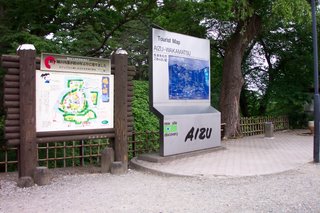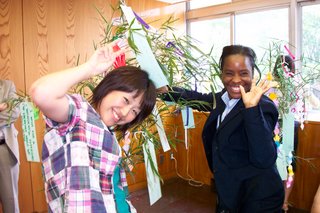Elementary --- June 21, 2006

The children eat lunch in their classroom. Some children were wearing masks and those serving were also wearing white smocks and hats. They went with the teacher to pick up the lunch, which had been prepared in the cafeteria. Meanwhile, other children put desks together to form little tables.
The students made a place for me. Each child had his own placemat on his desk.When the teacher and servers returned, children lined up, got their lunches and returned to their seats. No one started eating until everyone was served. The teacher ate at her desk. Over the loudspeaker classical musical played during lunchtime.The lunch was very healthy. It consisted of rice, miso soup, salad, salmon and milk. All students ate the school lunch.My classroom teacher commented on how well I was able to use the chopsticks. Every child in my class ate all the lunch. They cleaned their plates.
Matsunaga Elementary School- June 21, 2006

The peace sign is very popular in pictures.

Students working on math - addition was the topic today.

Students lined up for our welcome assembly.

Today we are visiting one of Aziuwakamatsu City’s elementary school. The name of the elementary school is Matsunaga Elementary School. Our day started with us greeting the students as they arrive at school.
A Castle Town --- June 20, 2006
The Byokkotai, or White Tiger Warriors, a group of teenage warriors, after being defeated in a battle against the imperial forces, 20 members of the Byakkotai retreated to Mt. Iimoriyama. When they saw Tsurugajo burning, they thought it had fallen to the enemy and 19 of them committed ritual suicide. Their graves lie together on that hillside. They are remembered as examples of the samurai code.

In 1868, during the Bolshin Civil War, in which the imperial army fought the Tokugawa Shogunate regime, the castle was attacked by troops of the new government who were for the Meiji Restoration and in 1874 it was finally demolished.In 1934, the castle ruins were declared a national historical site and the current castle tower was rebuilt on the original site in 1965.


It was originally built in 1591 as a 7-story castle, damaged in an earthquake in 1611 and rebuilt as a 5-story castle in 1539.The huge stone wall is original and the castle is a symbol of the samurai culture of Aizuwakamatsu.


Aizuwakamatsu City is a castle town. Today after lunch our sight seeing continued with Tsuruga-jo Castle.
Meet the Aziuwakamatsu City Mayor and Superintendent-- June 20, 2006

Lunch today was provided by the city. We at an awesome Japanese style restaurant.



We also met with the superintendent. We talk with JET program teacher who have taught and lived in Aziu for at least a year.

The day began with a meeting with the Aziuwakamatsu City Mayor.
The mayor was very happy to talk with us. He told us what Aziu was famous for:
Mayor Kanke is very proud of his city.
Fukushima University-- June 19, 2006

Today we are scheduled to visit Fukushima University. Our day began with a panel discussion with the Fukushima faculty members. 

After the panel discussion we were taken to the roof to see an area review of the campus.


Next we met with Fukushima, education students. We were able to talk with them about their education. The students were very friendly and open.


The students we met had each of us to write our wish to place on the wish tree. Our day ended at Fukushima University with lunch in the student union.

Travel to Aziu-- June 18, 2006

Today we traveled by bus to Tokyo Station where we boarded the Bullet Train To Aziuwakamatsu, Fukushima. The train ride was about 2 and a half hours.
Free Day - June 17, 2006

Today was truly a day of adventure. Michelle and I attempted to see Tokyo on our own. Be received detailed directions from the travel desk and set out to see Tokyo. Our first stop was to return to Asakusa. In Asakusa we shopped and just explored without a time frame.

We then jumped on the subway to head to Shubya (Tokyo's Time Square). We explore the Tokyu Department Store and Market in search of lunch. Finding a suitable place to eat was a challenge but we found an awesome restaurant that was buffet and served a great mix of Japanese and American food. Chef's Party was excellent.


Math and Aziu-- June 16, 2006
Today we heard special presentations. I attended the Math and Japan US Collaboration Education.
We ended the day meeting our group coordinator- Megumi "like Meg Ryan"- She showed us from the start she was very organized .
Japanese Government Members- June 15, 2006
We ended our day with presentations from Diet Members from the House of Representations and House of Counselors
We also heard a detailed presentation of Japanese Economy from Manabu Fukuda- Cheif Compliance Officer, Hong Kong & Shanghai Banking Corporation Limited.
More Sight Seeing - The Imperial Palace- Asakusa June 15, 2006
JFMF Staff arranged lunch a tempura (Fried Food)resturant. Tempura is very popular.
The National Diet of Japan- June 15, 2006

The first stop on our sight seeing tour was The National Diet of Japan - House of Representatives. The Diet is similar to our government buildings.
The House of Representatives and the House of Councils jointly exercise the powers of the National Diet through the passage of bills and measures by both Houses. The diets powers include:
- Enactment of laws
- Decisions regarding the budget and other matters related to national finances
- Decisions regarding approval for the conclusion of international treaties
- Designation of the Prime Minister
- Initiation of amendments to the constitution
Traditional Japanese Theater- Kabuki

Mark Oshima gave a great presentation on kabuki. During this presentation we learned that most Japanese people do not know a lot about Traditional Japanese theater. Japanese theater is not taught in school and most people do not attend performances.
Kabuki combines song, dance and acting. We had a rare opportunity to watch a demonstration of the dancer, Nishikawa Masako, getting ready by putting on her makeup, kimono and wig. The process for Masako is long and complicated.




Traditional Japanese Theater- Kyogen
Our Japanese education continued with traditional Japanese theater. An American, Don Kenny, did a presentation on kyogen. Kyogen is a form of comedy performed to musical accompaniment. Most of the plays are for 2 characters. The movements and dialogue in kyogen are typically very exaggerated and the emphasis is on the dialogue and action rather than music and dance.
The play that Mr. Kenny and his fellow actor presented was called "The Dwarf Tree Thief".

Mr. Kenny showed us the masks that are used in kyogen. Masks are only used for nonhuman or for very ugly characters.


Day one in Tokyo Japan - June 14, 2006
Today we experience our first Japanese breakfast. Japanese breakfast is very unique. The types of food that is generally offered for breakfast is as follows: fish, vegetables, miso soup(which is a fish based broth) and tea. Green tea is very popular.
Our Keynote Speaker was Tsutomu Kimura. He is the President of the National Institution for academic Degrees.

He spoke about Education Reform in Japan. He gave us a lot of information about the performance of Japanese children and also about the problems that schools and families currently face. Although Japanese children rank very high in academic performance in comparison with children in other countries, their rank has dropped in the last few decades.
This concerns education officials. Some of the current problems are:
- Japanese children are under stress and there is excessive competition in examinations to get into high school and universities.
- Japanese children have large amounts of knowledge, but are lacking in the ability to learn and think by themselves and to apply this knowledge.
- Kindness to others, respect of life and human rights are not significantly fostered, resulting in more incidences of school violence and bullying
The outcome of these studies have fostered a movement of reforms that are being implemented to nurture a "zest for living"in order to cope with an acutely changing society:
Japanese students need further help with:
- the ability to identify problems for oneself,
- learn by oneself,
- think for oneself,
- make independent judgments and actions and solve problems properly
- to develop a rich sense of humanity to be capable of self-reliance,
- cooperation with others and compassion for others.
- to develop health and physical strength to live a vigorous life.
The future model for education also promotes more free time for children and liaison between schools, families and communities.
Akasaka Prince Hotel in Tokyo.


The hotel, I must say again is awesome. My room is excellent, it has so much space and the bathroom was really nice.
The view from the 28th floor is great.

We have Arrived---June 13, 2006

Today we left San Francisco for Tokyo. This was very exciting for me. This was my first overseas flight (10 hours!!). We also had to cross the International Dateline. We arrived at Narita Airport at 2:15 Tuesday June 13, 2006. Therefore we lost a day. Once we went through immigration and customs we met our guides.
After we assembled as a group with our guides we boarded a bus to take us to our hotel. We checked into the Akasaka Prince Hotel in Tokyo.
This hotel was awesome. I stayed on the twenty- eighth floor. Upon arriving at the Akasaka Prince we were instructed not to give into jetlag. We were asked to go to dinner with JFMF volunteers.


















































